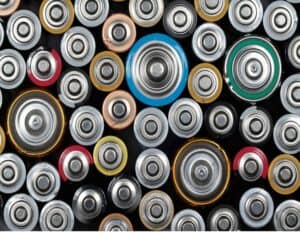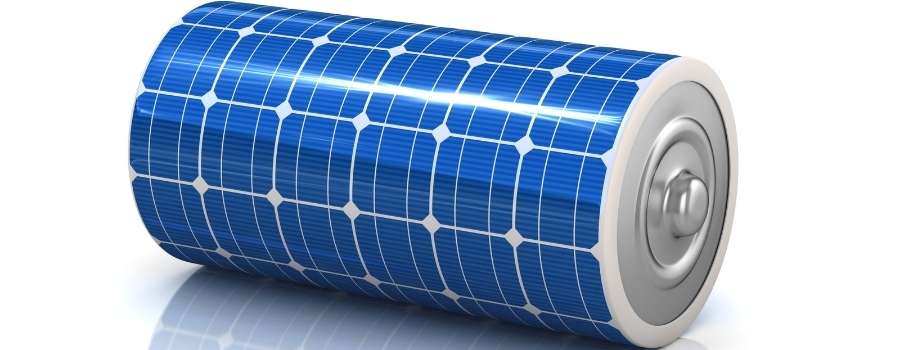
Solar-powered lighting can dramatically cut down on your utility bills, help you lead a greener lifestyle, and open up a world of outdoor lighting opportunities that simply wouldn’t have existed if you needed to run traditional power lines to them.
Solar lighting is often touted as “set and forget,” and to some degree it is. However, there are some things you should be aware of. One aspect of solar lighting that you may need to replace or troubleshoot is the batteries, and I often see these 9 questions come up in forums or video comment sections:
- Why Do Solar Lights Need Batteries?
- Are Solar Light Batteries Different Than Rechargeable Batteries?
- Why Do Batteries in Solar Light Have to Be Rechargeable?
- What Type of Batteries Are Best for Solar Lights?
- Are NiMH, NiCd, or Li-ion Batteries Best For Solar Powered Lights?
- What Size Battery Do Solar Lights Use?
- Can I Charge Solar Light Batteries In A Charger?
- Are All Solar Lights Battery Powered?
- Can I Use a Higher mAh Battery in Solar Lights?
Why Do Solar Lights Need Batteries?
Solar-powered lights need batteries in order to store the energy that they accumulate from the sun during the day. As soon as the sun goes down, the small solar array built into solar lighting stops producing energy so the bulb relies on the energy stored in the batteries to produce light.
This means that if your solar lights were running purely off of solar energy they would only be able to run in the daytime.
You need a way to capture all of the energy that the sun is delivering through the solar panel array you have set up for your lighting installation…either built right into the lighting fixture itself or set up somewhere else on your property…some solar string lighting and solar garden lighting have a separate solar panel that is used for multiple lights.
No technology does a better job of storing energy than high-quality batteries. Without quality batteries, you’re simply not going to be able to flip the lights on when the sun goes down. That pretty much neutralizes their effectiveness completely.
Solar Batteries Provide a Backup Source of Energy
Of course, another reason that solar lighting options usually have battery technology built right in is that these batteries can be used as modular power plants for other pieces of technology, too.
Sometimes these solar light batteries need to be modified a little bit to give power to something that hasn’t been designed to run off of their power plant.
But most of the time these modifications are almost effortless to pull off, and sometimes…especially in the case of completely rechargeable batteries…these battery units can be popped right out of a solar panel or solar lighting fixture and dropped into something else, providing instant electricity on demand.
Are Solar Light Batteries Different Than Rechargeable Batteries?
Since solar lights use rechargeable batteries and most standard-use batteries are designed to be rechargeable, there isn’t a difference between the two. Since most rechargeable batteries are Nickel Cadmium (NiCd) or Nickel Metal Hydride (NiMH,) they can be used interchangeably in solar lighting.

The vast majority of “off-the-shelf” batteries that you find in your local grocery or department store are going to be rechargeable. All you really need to consider is the size of battery in your solar lighting…AA, AAA, etc.
It is possible that you have solar lighting with built-in batteries, which makes changing them more difficult.
These solar lights are generally designed to be thrown out or recycled once they’ve died. However, with some simple tools and a little know-how, it is possible to crack these open to get to the batteries and replace them.
It’s also possible to run into non-standard-sized batteries in some solar lighting. This is going to be the shorter, stubby batteries or flat, disk-like batteries that come in some electronics.
These might be a little hard to find in stores like Walmart or Target, but are easily found in specialty battery stores (Batteries+ here in the US) or online…just make sure you know what size you’re purchasing since these batteries are usually quite a bit more expensive than AA’s.
I go into more differences between solar batteries and standard batteries here: The Differences Between A Solar And Normal Battery
Why Do Batteries in Solar Light Have to Be Rechargeable?
You need rechargeable batteries in solar lights because the batteries will be drained after each use. Solar energy needs to be stored since the solar array is only good at capturing solar energy. If the batteries were not rechargeable, then they would be useless after one or two usages.
Sometimes it’s easy to forget that batteries running off of solar power are going to be recharging and discharging power pretty much around the clock, almost on a 24/7 basis.
Without that rechargeability these batteries would be completely useless!
Solar Batteries Need to Be Able to Cycle to Work with Solar Power Tech
Every moment that a solar battery is hooked up to a solar panel or solar lighting fixture with solar cells it is going to be fed electricity directly from the sun.
That energy is going to run through the battery cells, providing power that can be stored up and made available later down the line…but it’s going to be recharging the battery, often from a completely dead or nearly dead battery state, when the sun is shining.
The second that the sun goes down and that UV light isn’t triggering the chemical reaction in your solar cells your battery flips from recharge to discharge, providing energy to your solar lighting fixture.
Depending on the size of battery that you have (and a couple of other factors) your battery is likely going to spend the entire night discharging the power it was recharged with all day long.
And then it starts the process all over again the second the sun rises again!
Around and around again your batteries are going to go through the recharge and discharge cycle. They absolutely MUST have rechargeable capabilities or they aren’t going to work at all.

Even the Best Solar Batteries Lose Efficiency Over Time
On top of that, it’s also important to remember that even the best solar batteries (and I dive a bit deeper into what the best solar batteries are in just a moment) are eventually going to lose efficiency over time and need to be replaced.
Thanks to battery reconditioning technology, however, those “dead” batteries may be able to be brought back to life with a bit of time and a little bit of effort.
If so, they can even be pressed back into solar lighting action…after the reconditioning has completed, anyway…and their recharge capabilities refurbished back to as close to a “brand-new condition” as possible.
Traditional batteries simply die when they die, are almost impossible to recondition, and even if you were able to recondition them they’d only be able to withstand a single recharge and discharge cycle before they died all over again!
For some tips and tricks on troubleshooting and fixing solar-powered lights, check out these articles:
- Why Your Solar Lights Are Flashing And How To Fix It
- How To Revive Your Solar Lights That Have Stopped Working
What Type of Batteries Are Best for Solar Lights?
While there are a lot of different battery types out there to pick and choose from powering solar lights today, the most popular options are definitely nickel-metal hydride and nickel-cadmium options.
Both of these batteries have significant advantages over the older, out-of-date lead acid-style batteries that they replaced. NiCd (nickel-cadmium) is a little less popular than the NiMH (nickel-metal hydride) choices for a couple of reasons I’ll dig into in just a moment, though.
Nickel Cadmium (NiCd) Batteries
NiCd batteries became incredibly popular during the 1990s thanks to their much smaller form factor that was still able to maintain significant stores of energy…far more than lead-acid batteries could even if they were the same size.
Another huge advantage of NiCad battery technology, particularly when it came to solar lights, was their ease of rechargeability. These batteries take a charge really well, can maintain those charges for extended amounts of time, and have sky-high levels of performance even when the temperature drops.
On top of that, these batteries can be recharged in no time at all (with quick charging capability) – especially when hooked up to UV solar panels.
Nickel Metal Hydride (NiMH) Batteries
Nickel metal hydride batteries are a little bit older than NiCad batteries, but the technology is a lot more environmentally friendly while delivering similar performance benefits. That’s a big piece of the puzzle behind the success and popularity of these batteries, especially when it comes to solar lighting.
Nickel metal hydride batteries are not filled with toxic metals, not filled with toxic chemicals, and are still able to maintain charges for extremely long durations while performing well in very high or very low temperatures.
Another huge bonus of using nickel-metal hydride with UV solar lighting installations is that the power density on these batteries is off the charts, resulting in a lower discharge rate.
Great when paired with low energy consumption devices (which pretty much all solar-powered lighting would be considered), you can expect discharge rates that’ll last the entire night. These batteries will only self-discharge 1% (on average) per day when they aren’t in use, too.
Are NiMH, NiCd, or Li-ion Batteries Best For Solar Powered Lights?
Nickel-metal hydride (NiMH) and nickel-cadmium (NiCd) are great options for solar batteries, but NiMH batteries edge out NiCD since they are more environmentally friendly. Lithium-Ion (Li-ion) batteries aren’t always the best choice, mainly because they drain more quickly in hot temperatures.
More About Lithium-Ion (Li) Batteries
Plenty of people are going to be surprised not to see lithium-ion batteries mentioned that much on this breakdown, but there’s a reason for that.
There are a lot of positives to using lithium-ion batteries in solar lighting technology, but there are some huge drawbacks that can’t be overlooked.
- First, high temperatures degrade this battery technology almost instantly.
When you’re talking about solar lights and batteries that are going to be left out in direct sunlight all day long, for days on end, you’re going to experience higher temperatures and lithium-ion degradation. - On top of that, these batteries can be pretty fragile and necessitate the use of their very own protection circuit. That increases the complexity and the expense of producing solar-powered lights, something most people are looking to avoid whenever possible.
- Throw in the fact that these batteries just don’t last as long as NiCad or nickel-metal hydride batteries do…lithium-ion battery packs can give you between two and three years of consistent life before falling off a performance cliff…and it’s not hard to look in a different direction.
What Size Battery Do Solar Lights Use?
Typically, solar lights will use 1.2 V (500 to 900 mA) NiCd or 1.2 V (1000 to 2000 mA) NiMH batteries. In both cases, sie AA is most common with up to 4 of these batteries being used. Less common, but also frequently used, are 3.2 V batteries.

These batteries are going to have plenty of storage to last the night, plenty of “juice” to power energy-hungry incandescents and floodlights, and more than enough to run power-sipping LEDs.
You’ll want to be sure that you find the right size battery for the solar lighting setup that you’re working with, though.
Most of the time you’re going to be looking at lighting installations that call specifically for either 1.2 V or 3.2 V batteries…as these are easily the most common sizes in the solar lighting world today.
mAh is Less Important to Focus On
A lot of people operate under the impression that the mAh of the batteries you choose has a huge impact on the overall performance of your lighting technology.
To some degree, this rating is important, it dictates how long of a run time you’ll be able to expect to get out of your lights with a specific battery, but it’s not nearly as important as matching the right size and chemistry of the battery you choose to the lights that you are installing.
That’s where your research needs to be focused when purchasing batteries for your solar lighting…when in doubt, read the manual!
Can I Charge Solar Light Batteries In A Charger?
Since the batteries used in solar lights are generally rechargeable batteries, you can use a battery charger that is designed to work with the same size battery (usually AA) to refill them. Using a charger is helpful if your lights have limited access to the sun or if they have been in storage.
The only times there may be an exception is if your solar lighting has a sealed battery pack…this is rare but can happen. Even in this situation, you can usually take the light apart to access the batteries, just use caution since breaking any of the components will basically ruin the lighting.
Some solar lights use non-standard sized batteries…in these cases, you wouldn’t be able to recharge them since the vast majority of battery chargers are designed to work with the most common sizes of batteries: AA, AAA, etc.
Are All Solar Lights Battery Powered?
While the majority of solar lights are engineered to take advantage of battery power technology, not every single solar light is going to have the capability to accept batteries. In these cases, the solar lights may be tapped into a traditional power grid.
Almost All Solar Lights Use Battery Power
Circling all the way back to what I said earlier, it’s important to remember how this lighting technology is getting electricity for operation in the first place.
The sun provides UV rays that are captured by the solar tech you are using to convert that energy into electricity, and then that electricity is either used immediately or is stored somehow for use later down the line.
Since we are talking about solar-powered lighting installations here, the odds are pretty good that the second option is what these solar solutions are going to be engineered for, storing power while the sun is up to be used when the sun is down.
This is why you’ll find most solar lights have batteries built right in or are designed to take advantage of battery tech to begin with.
Some Solar Lights are Tapped Into Traditional Grid Power, Too
Other solar lights, though, really act as solar energy collectors that transfer power into some type of grid – maybe into the same grid that your home runs off of, or maybe into “battery banks” that power all kinds of things around your home (including lights).
Some people even use solar lights with built-in solar panels to simply capture enough energy to somewhat offset their cost of operation.
These kinds of folks will end up selling the electricity they generate from these solar lights back to the electricity company while actually running the lights themselves off of the same juice they get from that power grid.
Speaking of selling electricity back to electric companies, I wrote a few articles about how to use excess solar power:
Can I Use a Higher mAh Battery in Solar Lights?
You can use higher mAh (milliampere-hours) rated batteries in solar lighting in order to get some extra run time and extra battery capacity. However, doing so will not make the lights themselves shine any brighter as this is reliant on the bulb itself, nor will it make them more energy efficient.
Instead, you’re going to get batteries that can soak up more energy produced by the UV rays produced by the sun and…generally…batteries that are going to discharge a little slower.
Some people find that these kinds of batteries last a little bit longer in solar lighting installations, which is probably how they became so widely recommended, but a lot of that has to do with the slower charge and discharge cycles that we just spoke about.
At the end of the day, as long as you keep all of the inside information highlighted throughout this guide in mind when it comes time to invest in batteries for your solar lighting setup you’ll be pretty happy with the results!
For more information on solar lighting safety and tips, check out these articles:
